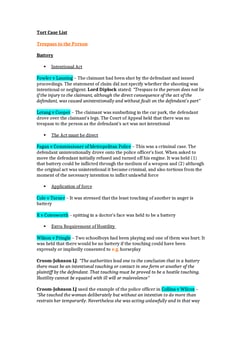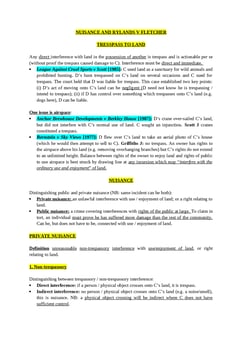Hunter v Canary Wharf [1997] AC 655
Judgement for the case Hunter v Canary Wharf
KEY POINTS
-
Private nuisances are of three kinds. They are:
Nuisance by encroachment on a neighbour's land;
Nuisance by direct physical injury to a neighbour's land; and
Nuisance by interference with a neighbour's quiet enjoyment of his land. (Lord Lloyd)
In the case of nuisances "productive of sensible personal discomfort," the action is based on the harm on the land rather than on the inconvenience to the individual.
FACTS
-
This case stems from two previous cases:
In Canary Wharf Ltd., the appellants (plaintiffs) claim damages for interference with their TV reception caused by the construction of the Canary Wharf Tower, which they believe disrupted the TV signals from a nearby transmitter. The interference began during the tower's construction in 1989 and continued until a relay transmitter was established in 1991. They base their claim on nuisance and negligence. The key legal issues in this action are whether interference with TV reception can be considered an actionable nuisance and whether a property interest is necessary to sue in private nuisance.
Meanwhile, in London Docklands Development Corporation, the respondents (plaintiffs) in this action seek damages due to excessive dust generated during the construction of the Limehouse Link Road by the appellants. The road construction occurred between 1989 and 1993. Initially, they brought claims in negligence, nuisance, and under the Rule in Rylands v. Fletcher, though they later abandoned the last claim. The primary legal issue in this action is whether an interest in property is required to bring a claim in private nuisance.
Judge Havery Q.C. initially ruled in favour of the appellants on both legal issues in Canary Wharf Ltd., but was overturned by the Court of Appeal, which favoured the respondents on both issues. Now, the appellants in Canary Wharf Ltd. are appealing to the House of Lords against the Court of Appeal's decision regarding the first issue.
Meanwhile, the defendants in both actions are appealing or cross-appealing against the Court of Appeal's decision on the second issue, related to the requirement of an interest in property for a private nuisance claim.
JUDGEMENT
Appeal dismissed.
COMMENTARY
The case is noteworthy for its influence on the evolution of nuisance law in the UK and its explanation of the parameters for what qualifies as actionable nuisance.
It emphasises how crucial it is to draw a distinct line in the law between subjective discomfort and a valid legal claim based on an infringement of property rights.
ORIGINAL ANALYSIS
Plaintiffs, local residents, claimed actionable nuisance against Defendant during the erection of canary wharf, which interfered with their TV signal.
-
HL held:
That TV interference was not an actionable nuisance, and
that of those affected, only those with exclusive possession of property could sue.
Lord Goff
On point (1): As a general rule, a man's right to build on his land is not restricted by the fact that the presence of the building may of itself interfere with his neighbour's enjoyment of his land.
On point (2): Only freeholders, tenants in possession, licensees with exclusive possession or, exceptionally, people in possession but without a right to be there, can sue. NOT mere licensees.
-
Without this restriction it would be uncertain what the limits are on who can sue i.e. floodgates
(No: the CA had proposed those with a “substantial link” to the land, to be resolved through litigation)
Lord Hoffmann
In the category of “material damage to property”, the tort is concerned with damage to land, not persons. Hence only a person with title to the land can claim for compensation for damage to it.
He says that the second category of “sensible personal discomfort” is also for compensating damage to the land, since it is the injury inflicted upon the land that causes the sensory discomfort.
Hence for this category too there has to be title.
Cane, “What a nuisance”
Hoffmann is wrong because: Firstly it fails to take account of tort law’s underlying principle of fault-based unreasonableness; secondly it fails to explain why a party may sue for property damage and personal-injury negligence without the need for title to property, but not loss of amenity.
Lord Cooke
(agreeing on point (1) but dissenting on point (2)): It is an unjustified discrimination against unofficial residents to require proprietary interest e.g. the wife/children of an official resident.
There are no floodgates/definitional problems since many common law jurisdictions take this approach to nuisance. All those living in the home should be able to enforce, and litigation would work out the borderline cases.
RELATED CASES
For Further Study on Hunter v Canary Wharf
Need instant answers? Our AI exam tutor is here to help.
Ask questions 🙋 Get answers 📔 It's simple 👁️👄👁️
Our AI is educated by the highest scoring students across all subjects and schools. Join hundreds of your peers today.
Get StartedSimilar Cases
Related Product Samples
These product samples contain the same concepts we cover in this case.
| GDL Tort Law | Land Torts Notes (12 pages) |
| Tort Law | Nuisance Notes (70 pages) |
| GDL Tort Law | Private Nuisance Notes (9 pages) |


